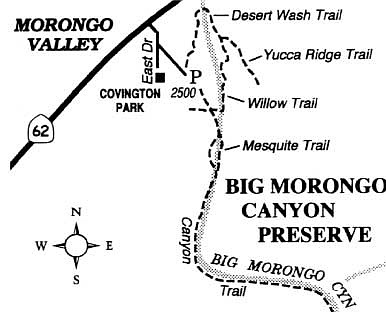 Facebook
Facebook
 X
X
 Instagram
Instagram
 TikTok
TikTok
 Youtube
Youtube
The two major subdivisions of the California desert (the Mojave and Colorado Deserts), plus an outlying stretch of chaparral habitat, intersect in the 4500-acre Big Morongo Canyon Preserve, north of Palm Springs. Bighorn sheep, bobcats, mountain lions, mule deer, and nearly 300 species of birds have been spotted in or near the preserve. The most agreeable feature here, a freshwater marsh in the canyon bottom, owes its existence to seepage of water upward along a rift associated with the San Andreas Fault.
The perennially moist part of Big Morongo Canyon lies about 2000 feet in elevation higher than torrid Palm Springs, so the early autumn heat is tolerable here, even at midday. It's best to take advantage of the early-morning or late-afternoon hours, though. The preserve is open daily from 7:30 a.m. to sunset.
From Interstate 10 near Palm Springs, drive 11 miles north on Highway 62 to Morongo Valley. Just past the business district turn right on East Drive, and look for the Big Morongo entrance on the left.
For a rewarding one-mile stroll through contrasting habitats, walk past the visitor information display and pick up the Desert Wash Trail on the left. It guides you over a sun-blasted terrace dotted with honey mesquite, desert willow, and yerba santa. The latter exudes an unmistakable sweet-pungent odor. You dip to cross Big Morongo Wash and pass a spur trail, the Yucca Ridge Trail, over one-half mile from the start. Continue on the Willow Trail, which will take you through the heart of Big Morongo's riparian oasis. There you meander on boardwalks amid a junglelike array of willows, cottonwoods, alders, and fan palms. Watercress and water parsnip have overrun the surface of the shallow waters below your feet.
After a short half-mile on the Willow Trail, you come to a trail intersection. Off to the right a short distance is your parked car. To the left, on the Mesquite and Canyon Trails, you can follow the waters of Big Morongo Canyon down as far as you like. At some point within about a mile (more or less depending on the amount of recent rainfall), the porous soil of the canyon bottom swallows all traces of surface water, and only a dry streambed lies beyond.


The two major subdivisions of the California desert (the Mojave and Colorado Deserts), plus an outlying stretch of chaparral habitat, intersect in the 4500-acre Big Morongo Canyon Preserve, north of Palm Springs. Bighorn sheep, bobcats, mountain lions, mule deer, and nearly 300 species of birds have been spotted in or near the preserve. The most agreeable feature here, a freshwater marsh in the canyon bottom, owes its existence to seepage of water upward along a rift associated with the San Andreas Fault.
The perennially moist part of Big Morongo Canyon lies about 2000 feet in elevation higher than torrid Palm Springs, so the early autumn heat is tolerable here, even at midday. It's best to take advantage of the early-morning or late-afternoon hours, though. The preserve is open daily from 7:30 a.m. to sunset.
From Interstate 10 near Palm Springs, drive 11 miles north on Highway 62 to Morongo Valley. Just past the business district turn right on East Drive, and look for the Big Morongo entrance on the left.
For a rewarding one-mile stroll through contrasting habitats, walk past the visitor information display and pick up the Desert Wash Trail on the left. It guides you over a sun-blasted terrace dotted with honey mesquite, desert willow, and yerba santa. The latter exudes an unmistakable sweet-pungent odor. You dip to cross Big Morongo Wash and pass a spur trail, the Yucca Ridge Trail, over one-half mile from the start. Continue on the Willow Trail, which will take you through the heart of Big Morongo's riparian oasis. There you meander on boardwalks amid a junglelike array of willows, cottonwoods, alders, and fan palms. Watercress and water parsnip have overrun the surface of the shallow waters below your feet.
After a short half-mile on the Willow Trail, you come to a trail intersection. Off to the right a short distance is your parked car. To the left, on the Mesquite and Canyon Trails, you can follow the waters of Big Morongo Canyon down as far as you like. At some point within about a mile (more or less depending on the amount of recent rainfall), the porous soil of the canyon bottom swallows all traces of surface water, and only a dry streambed lies beyond.
